Class 7 Geography Chapter 4 Notes - Air
| Table of contents |

|
| What is Atmosphere? |

|
| Composition of the Atmosphere |

|
| Structure of the Atmosphere |

|
| Weather and Climate |

|
What is Atmosphere?
A huge blanket of air surrounding the Earth, crucial for the survival of all living beings is Atmosphere.
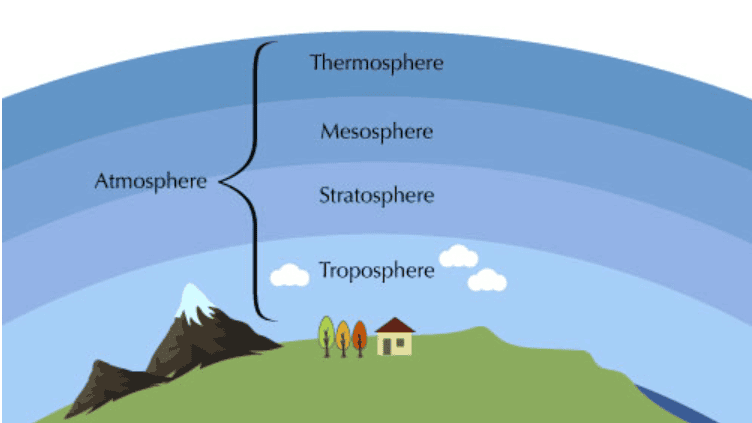
Functions of the Atmosphere:
- Provides breathable air.
- Protects from harmful sun rays.
- Regulates Earth's temperature, preventing extreme heat during the day and freezing at night.
Composition of the Atmosphere
Air is a mixture of gases including nitrogen and oxygen. There are also smaller quantities of carbon dioxide, helium, ozone, argon, and hydrogen in the air.
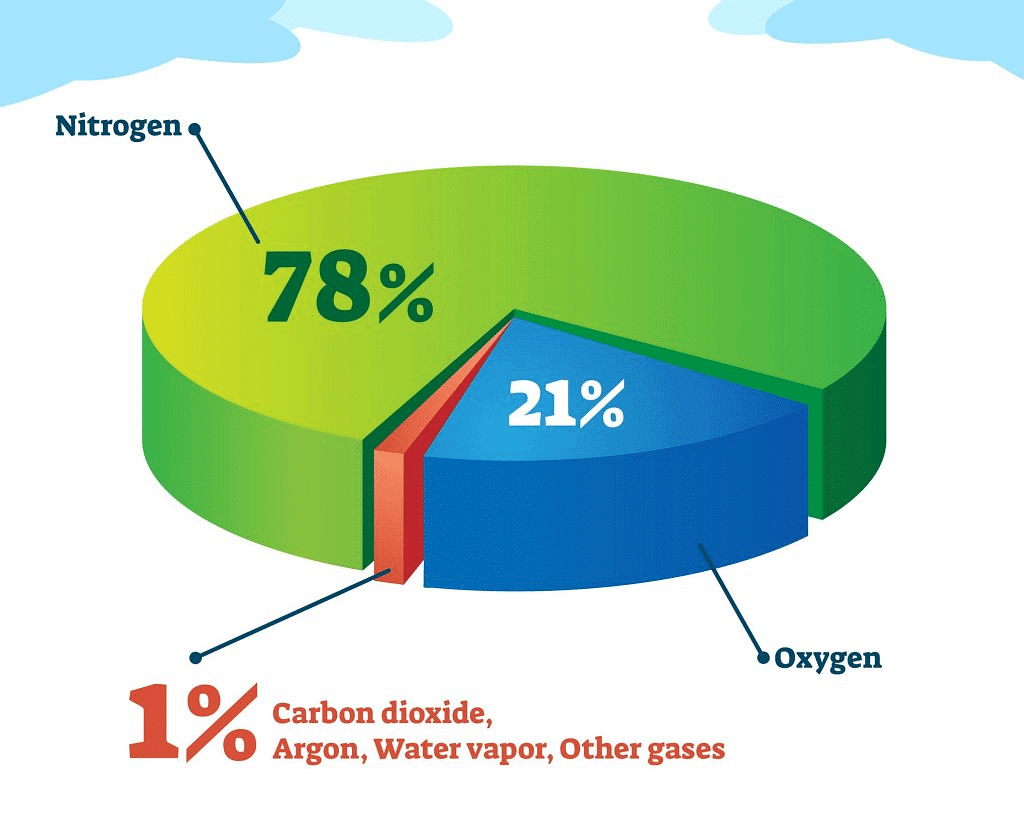 Composition of Air
Composition of Air
- Nitrogen (78%): Nitrogen is the most abundant gas in the air and is inhaled and exhaled by humans, but plants cannot directly take nitrogen from the air and rely on bacteria to convert it for their use.
- Oxygen (21%): Oxygen is the second most abundant gas in the air and is taken in by humans and animals while they breathe, and is produced by green plants during photosynthesis.
- Carbon Dioxide (0.04%): Used by plants in photosynthesis and contributes to the greenhouse effect. Excessive CO₂ from burning fossil fuels causes global warming.
- Other Gases (1%): Includes helium, ozone, argon, and hydrogen.
- Dust Particles: Also present in the air, they can affect weather and health.
Greenhouse Effect:
Carbon dioxide in the atmosphere creates a greenhouse effect by trapping heat radiated from the Earth. This process keeps the planet warm and habitable. However, increased levels of carbon dioxide lead to global warming, causing the Earth's temperature to rise.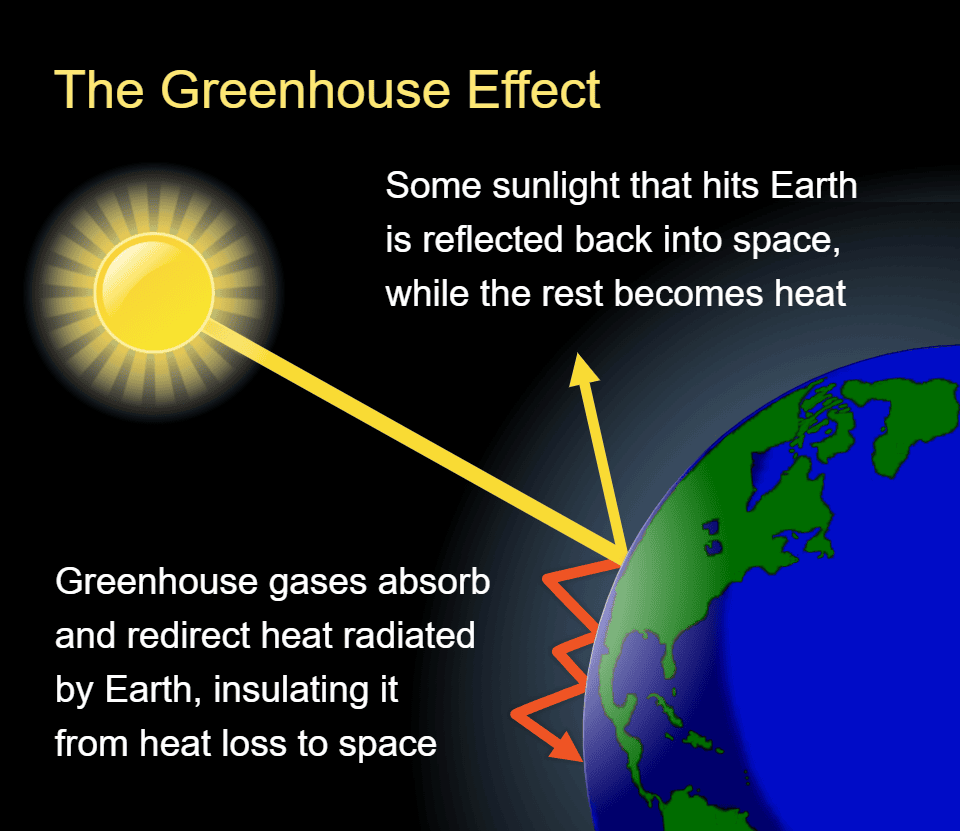 Greenhouse Effect
Greenhouse Effect
Global Warming & its Consequences:
Global warming refers to the long-term increase in Earth's average surface temperature due to the accumulation of greenhouse gases, primarily carbon dioxide (CO₂), in the atmosphere. These gases trap heat radiated from the Earth's surface, leading to a gradual warming of the planet. Consequences of Global Warming are:
- Melting snow and polar ice caps, leading to rising sea levels.
- Flooding in coastal areas due to the higher sea levels.
- Drastic climate changes, which can threaten the survival of plant and animal species in the long run.
Structure of the Atmosphere
The atmosphere is divided into five layers. The layers are Troposphere, Stratosphere, Mesosphere, Thermosphere, and Exosphere.
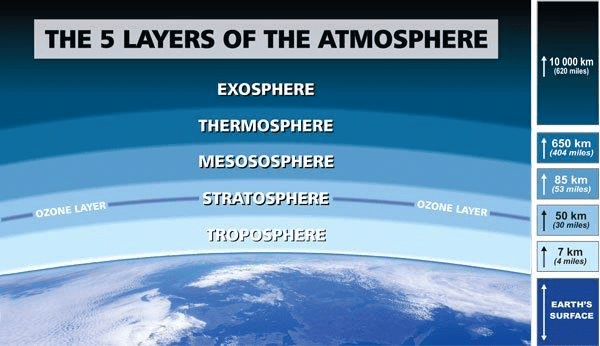 5 Layers of Atmosphere
5 Layers of Atmosphere
Troposphere
- The troposphere is the most important layer of the atmosphere.
- It is located at an average height of 13 km.
- The air we breathe is found in this layer.
- Weather phenomena such as rainfall, fog, and hailstorms occur in the troposphere.
Stratosphere
- The stratosphere is located above the troposphere and extends up to 50 km.
- It is mostly free from clouds and weather events, making it suitable for flying aeroplanes.
- The stratosphere contains a layer of ozone gas that protects us from the harmful effects of the sun's rays.
Mesosphere
- The mesosphere is the third layer of the atmosphere.
- It is located above the stratosphere.
- It reaches a height of 80 km.
- Meteorites burn up in this layer when entering from space.
Thermosphere
- The thermosphere has a rapid increase in temperature with height.
- The ionosphere is a part of the thermosphere.
- The ionosphere extends between 80-400 km.
- The ionosphere helps with radio transmission.
- Radio waves transmitted from the earth are reflected back by the ionosphere.
Exosphere
- The exosphere is the highest layer of the atmosphere.
- It contains a very thin amount of air.
- Helium and hydrogen gases float into space from this layer.
Weather and Climate
- Weather: Weather is the hour-to-hour, day-to-day condition of the atmosphere. Daily weather forecasts help us understand the weather patterns.
- Climate: The average weather condition of a place for a longer period represents the climate of a place. Weather can affect our mood and plans.

Temperature
Temperature measures how hot or cold the air is. It indicates the level of thermal energy present in the atmosphere.
Factors Influencing Temperature:
Daily and Seasonal Changes: Temperature varies throughout the day and across different seasons due to changes in atmospheric conditions.
Insolation: The amount of incoming solar energy, or insolation, affects temperature distribution. Areas closer to the equator receive more direct sunlight and have higher temperatures, while regions towards the poles receive less insolation and experience cooler temperatures.
Urban Heat Island Effect: Cities often have higher temperatures than surrounding rural areas due to the heat absorbed and radiated by concrete, metals, and asphalt. High-rise buildings in cities can trap warm air, further raising local temperatures.
Impact on Agriculture: If global temperatures rise excessively, it can negatively impact crop growth and agricultural productivity.
Earth's Temperature Measurement:
Celsius Scale: Temperature is commonly measured using the Celsius scale, devised by Anders Celsius. On this scale, water freezes at 0 degrees Celsius and boils at 100 degrees Celsius.
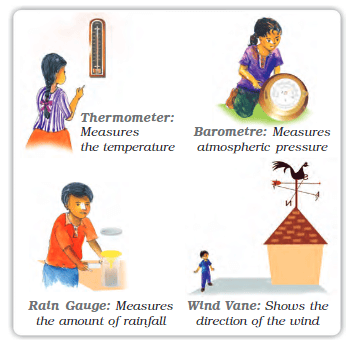 Instruments
Instruments
Air Pressure
Air pressure is the force exerted by the weight of air pressing down on the Earth's surface. Although this force is significant, we don't typically feel it because our bodies exert an equal counter-pressure.

Variation in Air Pressure:

Altitude Effects: Air pressure decreases with altitude. As you move higher in the atmosphere, there is less air above you, resulting in lower pressure.
Temperature Influence: Temperature affects air pressure distribution. Warm temperatures lead to lower-pressure areas, often associated with cloudy and wet weather. Conversely, cooler temperatures result in higher-pressure areas, which are usually linked to clear and sunny conditions.
Air Movement: Air moves from areas of high pressure to areas of low pressure, creating wind and contributing to weather patterns.
Air Pressure in Space:
- Space Suit Necessity: On the Moon, where there is no air or air pressure, astronauts must wear space suits filled with air to prevent bodily harm. Without these suits, the lack of pressure would cause their blood vessels to burst, leading to severe injury.
Air Circulation:
- Heating and Cooling Effects: When air warms up, it expands and becomes lighter, causing it to rise. In contrast, cold air is denser and sinks. This movement of rising warm air and descending cold air creates air circulation and helps regulate weather patterns.
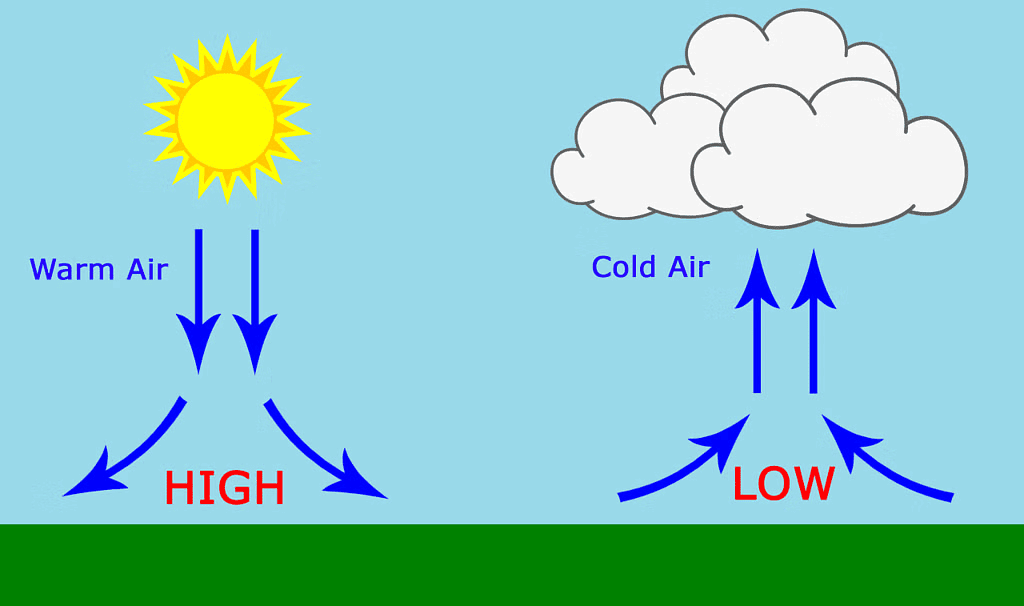 Heating and Cooling Effects
Heating and Cooling Effects
Wind
Wind is the movement of air from regions of high pressure to regions of low pressure. This movement is responsible for observable effects such as rustling leaves, uprooting trees, and dispersing smoke and dust. Strong winds can make it challenging to walk or hold an umbrella, highlighting their power and influence on daily activities.
 Wind
Wind
Types of Winds:
Permanent Winds: These winds blow consistently in specific directions. Examples include trade winds, westerlies, and easterlies.
Seasonal Winds: These winds change direction with the seasons, such as the monsoons in India, which shift depending on the time of year.
Local Winds: These occur in specific areas or times. Examples include land and sea breezes, and the hot, dry wind known as "loo" in the northern plains of India.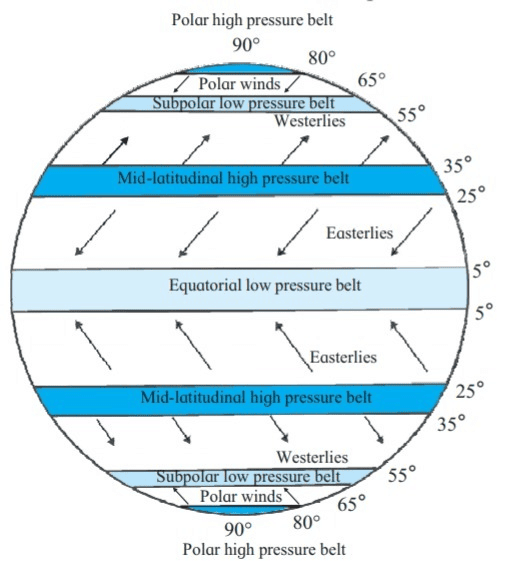 Major Pressure Belt and Wind system
Major Pressure Belt and Wind system
Moisture
Moisture refers to the presence of water in any form within the environment. It plays a crucial role in weather, climate, and various natural processes. Moisture is essential for sustaining life, influencing weather patterns, and maintaining ecological balance. Here's a breakdown of the key aspects of moisture:
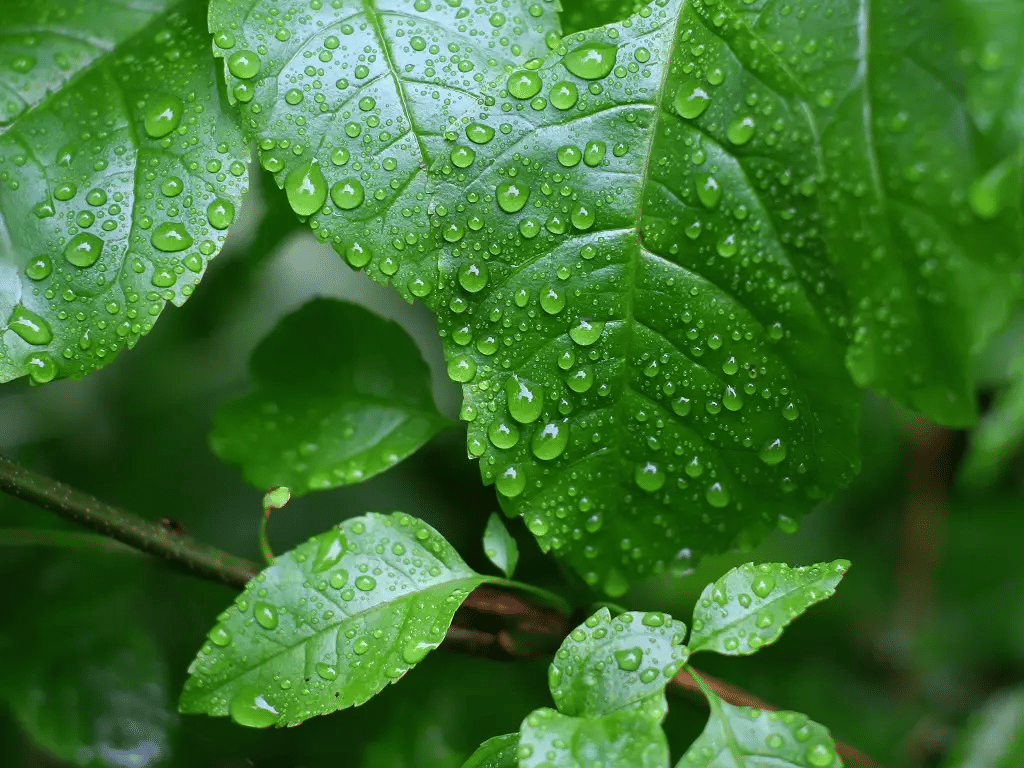 Moisture on Leaves
Moisture on Leaves
- Water Vapor: Water vapor is the gaseous form of water that evaporates from land and water bodies. It rises into the atmosphere and contributes to weather phenomena and climate regulation.
- Humidity: Humidity is the measure of the amount of water vapor present in the air. Warmer air can hold more water vapor, leading to higher humidity levels. High humidity affects comfort, drying rates, and weather conditions.
- Formation of Clouds and Precipitation: As water vapor rises, it cools and condenses into tiny water droplets, forming clouds. When these droplets combine and become heavy, they fall back to the ground as precipitation (rain, snow, sleet, etc.). Rainwater replenishes groundwater supplies. Variations in rainfall can lead to flooding or drought, impacting ecosystems, agriculture, and water resources.
- Types of Rainfall
Convectional Rainfall: Caused by warm air rising and cooling, leading to condensation.
Orographic Rainfall: Occurs when moist air is forced upwards by mountains, cooling and condensing into rain.
Cyclonic Rainfall: Results from low-pressure systems where warm, moist air is lifted and cooled. Types of Rainfall
Types of Rainfall - Rainfall is very important for survival of plants and animals.
|
63 videos|554 docs|46 tests
|
FAQs on Class 7 Geography Chapter 4 Notes - Air
| 1. What is the atmosphere and why is it important for life on Earth? |  |
| 2. What are the main components of the atmosphere? |  |
| 3. What are the different layers of the atmosphere? |  |
| 4. How do weather and climate differ? |  |
| 5. How does the atmosphere affect weather patterns? |  |
















